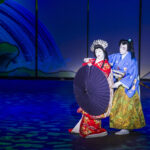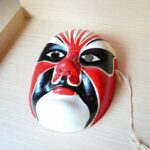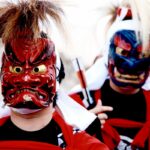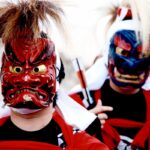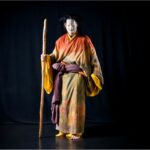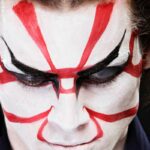Are you curious to learn about kabuki makeup? The dramatic theater performance known as kabuki is an art form. Every single detail you see on stage is there for a specific reason.

Whether the reason is to subtly tell you something to do with the story, to indicate a type of character, and much more.
As you might imagine, kabuki makeup is intricately worn in specific ways with specific colors to make the audience feel or see what they need to.
It is because kabuki is such a detailed and wonderful art form that we have gathered all the information that you might need to know about kabuki makeup.
So, let us dive right in and check out this comprehensive kabuki makeup guide.
What Types Of Kabuki Makeup Are There?
Kabuki actors will wear many different types of makeup. Styles, colors and patterns hold meaning in a kabuki theater.
If you are familiar with kabuki you will know that there are specific types of makeup used to indicate what kind of character is being played.
In this section we are going to take a closer look at these types of makeup and what they mean. So, without further ado, let us dive right in and get started!
Mukimiguma
It is typically used for actors playing characters that are symbolic of youthful sensuality and have a strong sense of justice.
This style goes by mukimiguma, this is because the simple shapes are supposed to resemble mukimi. Mukimi basically means something along the lines of ‘Shellfish without Shells.’
Where might you see this makeup in kabuki performances? Which characters make use of it? Below we have listed a few of these performances for you:
- The Fight Over the Carriage
- Sugawara and the Secrets of Calligraphy
- Sukeroku, the Hero of Edo
- The Revenge of the Soga Brothers
There are plenty of other kabuki plays that will make use of this type of makeup, but these are a few of the most famous ones.
Ipponguma
This type of makeup is most often used to indicate that a character is reliable. It can also be indicative of a character that is rough and rascally. This makeup is called ipponguma.
This name suggests that one vertical kuma is drawn. Kuma is a representative of a double chin, this line is often drawn beneath the jaw.
Below we have listed a few of these performances for you:
- Sugawara and the Secrets of Calligraphy
- The Thousand League Bamboo Forest
- The Gate to the Castle of the Lions
- The Battles of Coxinga
There are many other kabuki plays that will make use of this type of makeup. These are just a few examples.
Nihonguma
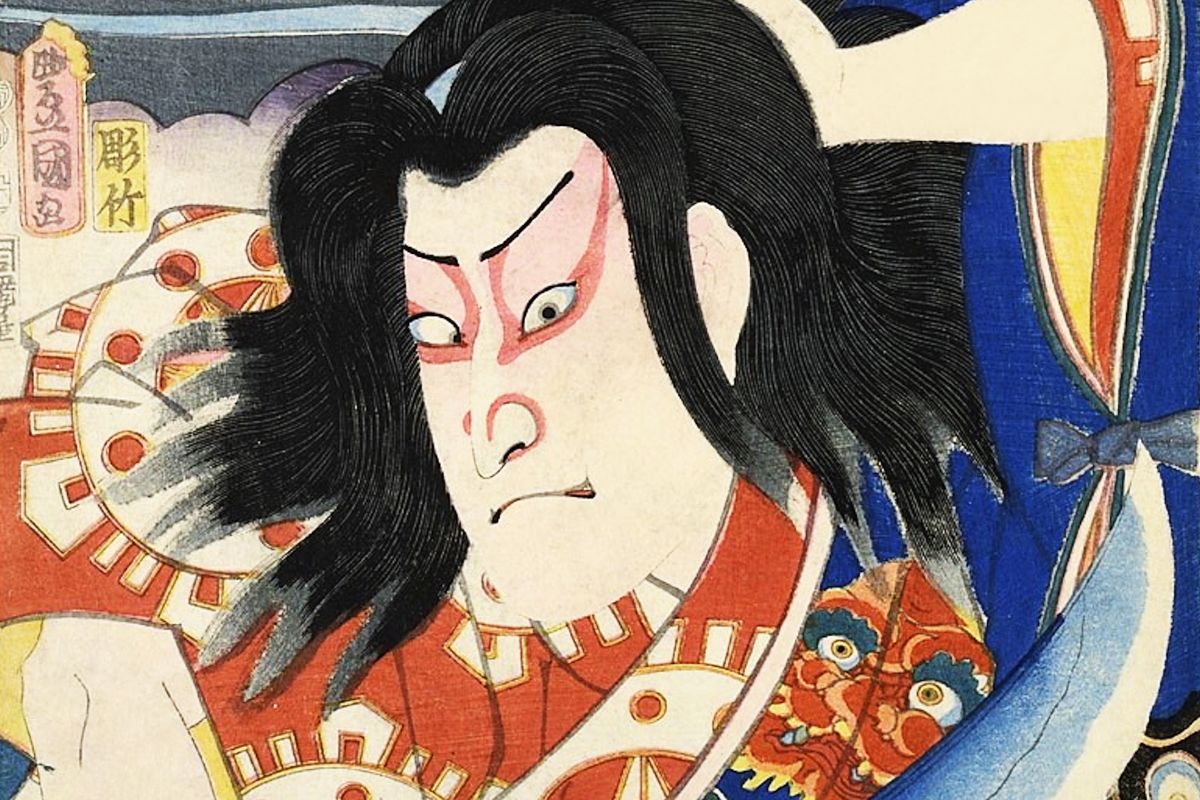
This makeup is most often used as a way to indicate that a character is strong, calm, and majestic. It is also used mostly for adult roles. The name nihonguma means two kuma.
These are representatives of the two kuma that are swept upwards from the eyes.
Below we have listed a few of these performances for you:
- The Fight Over the Carriage
- Sugawara and the Secrets of Calligraphy
- The Holy Man Narukami and Lady Taema
These kabuki plays are quite amazing, so if you happen to watch them make sure to look out for the nihonguma look.
Sujiguma
This makeup is most often used for characters that are heroes and have superhuman strength or abilities. These characters are also often filled with a strong intense anger.
The name comes from the multiple red kuma that are swept up and over the lines of the face.
Below we have listed a few of these performances for you:
- The Fight Over the Carriage
- Sugawara and the Secrets of Calligraphy
- Wait a Moment!
- Goro and the Arrows
These kabuki performances are all fantastic and you are likely to see this style of makeup in any one of them if you look out for it.
Kagekiyo No Kuma
This makeup type is most often used for characters that are valiant heroes. They have normally been captured and imprisoned by enemies. You may notice that they are often pale and thin.
The only kabuki play we have found that has this type of makeup is Kagekiyo in “Kagekiyo.
Kugeare
This type of kabuki makeup is most often seen in characters that are villains and have high status. These characters are also often keen to take over the country. The blue is supposed to make the character appear cold and eerie.
Below we have listed a few of these performances for you:
- The Fight Over the Carriage
- Sugawara and the Secrets of Calligraphy
- Wait a Moment!
The plays are all amazing, see if you can spot a character wearing the kugeare style of makeup.
Akattsura
If you see a kabuki character wearing this type of makeup they are usually thoughtless thugs. They will normally be thugs that are retainers or underlings of a greater villain.
Below we have listed a few of these performances for you:
- Wait a Moment!
- The Maison of Kawatsura Hogen, commonly called ‘Shi no kiri
- Yoshitsune and the Thousand Cherry Trees
- The Fight Over the Carriage
- Sugawara and the Secrets of Calligraphy
This striking makeup type is not easy to miss, you should be able to spot it in a kabuki play with ease.
Chaguma
This makeup will normally be used for characters that are human and transform into monstrous entities like ghosts, spirits or monsters.
Below we have listed a few of these performances for you:
- The Ground Spider
- The Demon
This striking makeup stands out in a crowd. But seeing the actor perform while wearing it really brings the character to life.
Saruguma
This type of kabuki makeup is usually worn by characters that are heroic samurai that are also humorous. The only kabuki play we have found that has this type of makeup is The Revenge of the Soga Brothers.
Namazuguma
This type of kabuki makeup will normally be worn by characters that are a little dense. The intention of them is usually to make the audience laugh despite their villainy.
The only kabuki play we have found that has this type of makeup is Wait a Moment!
What Do The Colors In Kabuki Makeup Mean?
The color of the makeup of kabuki actors is symbolic of certain things. Kesho makeup is considered to be ceremonial to kabuki actors. The designs. And colors are symbolic of various roles and types of characters. So, what do these characters mean?
Well, in a typical kabuki play you might see the following colors:
- Green – If a kabuki actor is wearing green makeup it may be indicative of an actor playing the role of a ghost or another type of spirit.
- Purple – If a kabuki actor is wearing purple then they may be playing a character that is nobility. Purple is considered to be a royal or high class color.
- Black – This color is most used by actors as a way to symbolize a goatee or eyebrows. It is also largely a color that villains will wear.
- Red – A kabuki actor that is wearing red may be indicative of a hero character type. It is also symbolic of strength, honor, virtue, and power.
- Blue – If a kabuki actor is wearing blue then it may be a way to indicate that a character is a villain. It can also be symbolic of a character that is from the spirit realm.
Colors can have a plethora of meaning which is why it is so important that these colors are chosen carefully for makeup looks and character portrayal.
Final Thoughts
Hopefully you have found this article enlightening. There are so many small details that go into this art form. As such the makeup will have a significant and important message to tell the audience.
If you enjoyed this article and want to learn something new about Japan then you should take a look at our website.
We have loads of articles covering a wide variety of topics to do with Japan. There is bound to be something out there that you will enjoy and find interesting.
- 16 Best Websites To Watch Japanese Movies With English Subtitles - May 11, 2023
- Is ZIPAIR The Best Airline For Traveling To Japan? - May 11, 2023
- Ryu Murakami Vs Haruki Murakami – Which One Should You Read? - May 11, 2023

